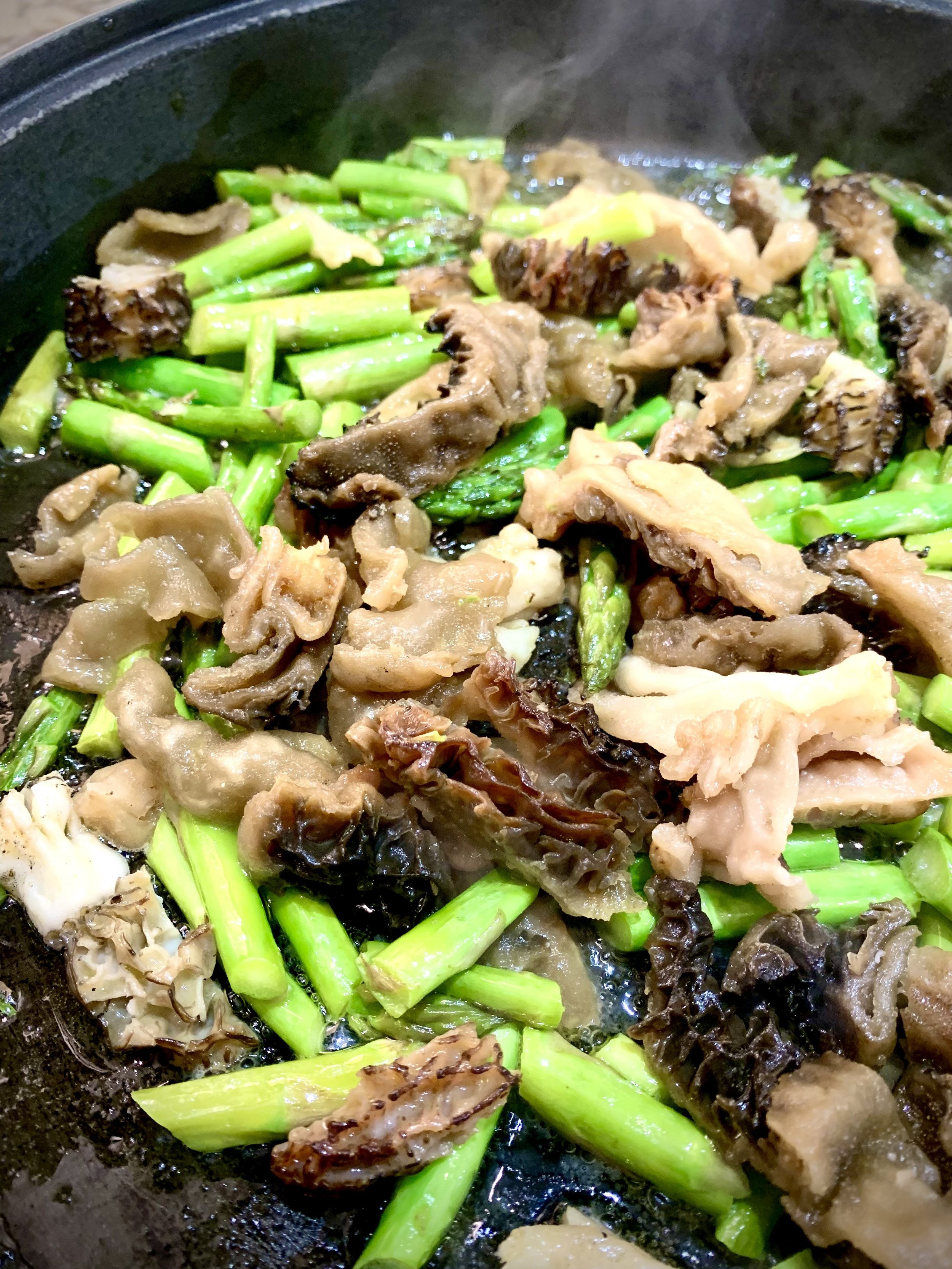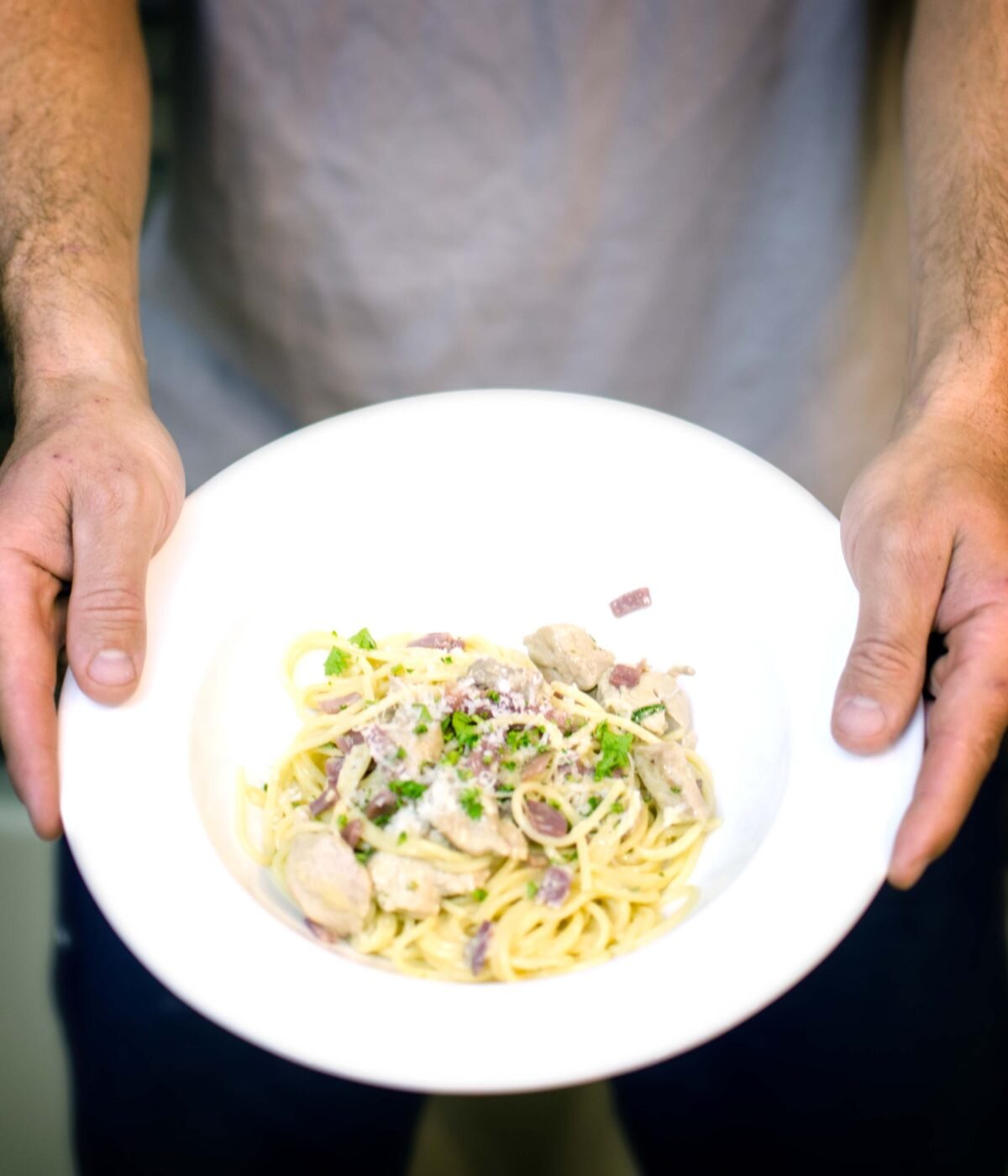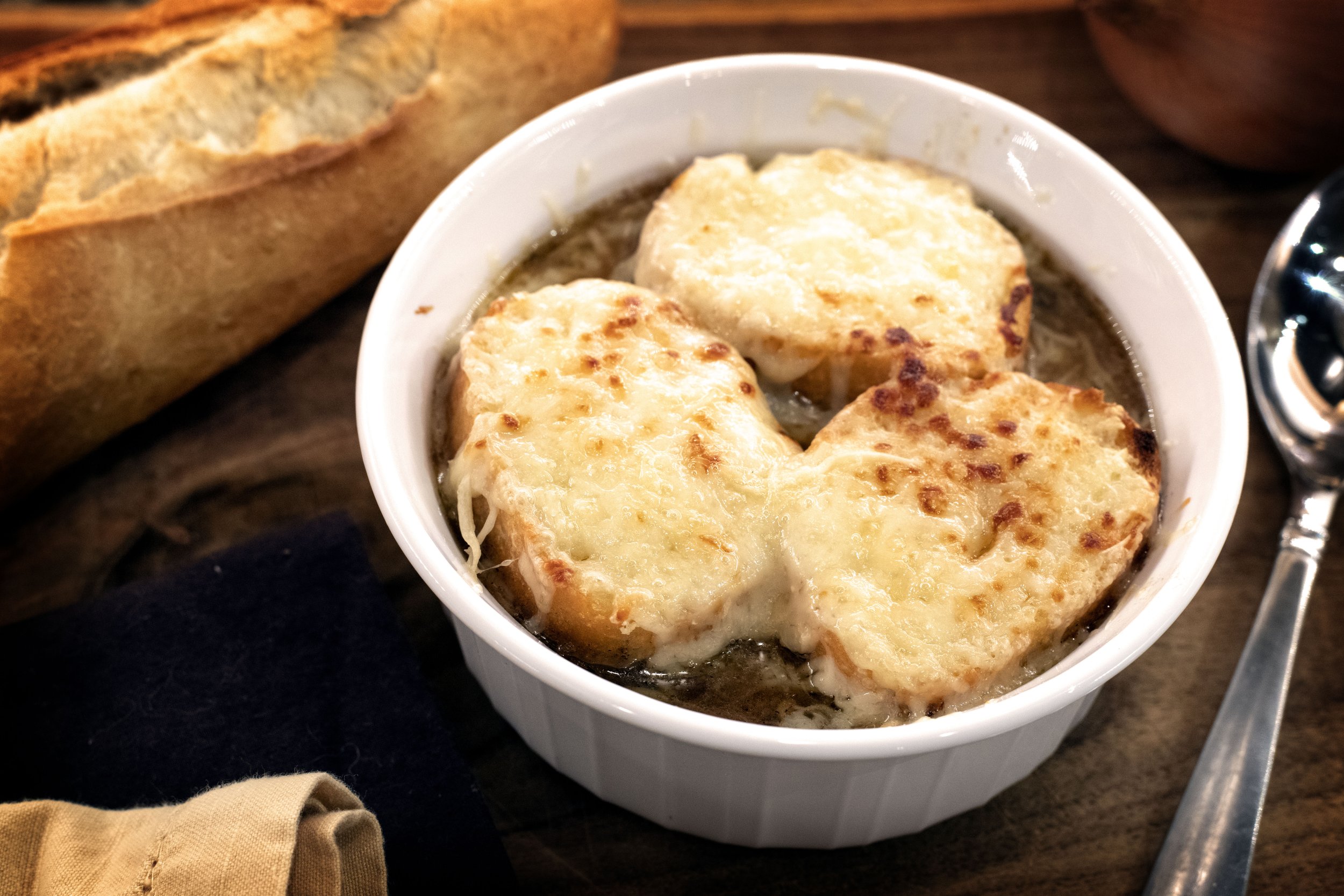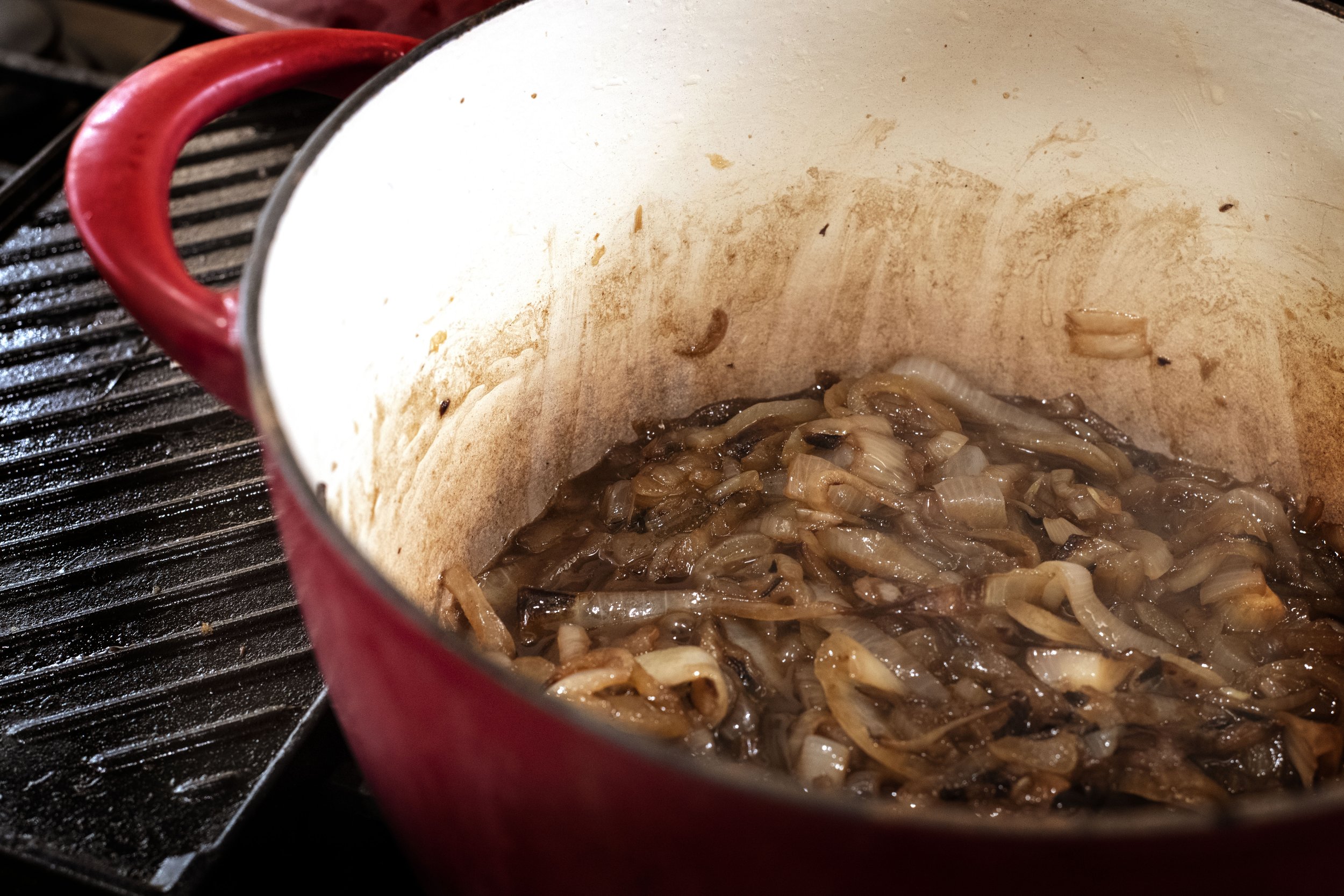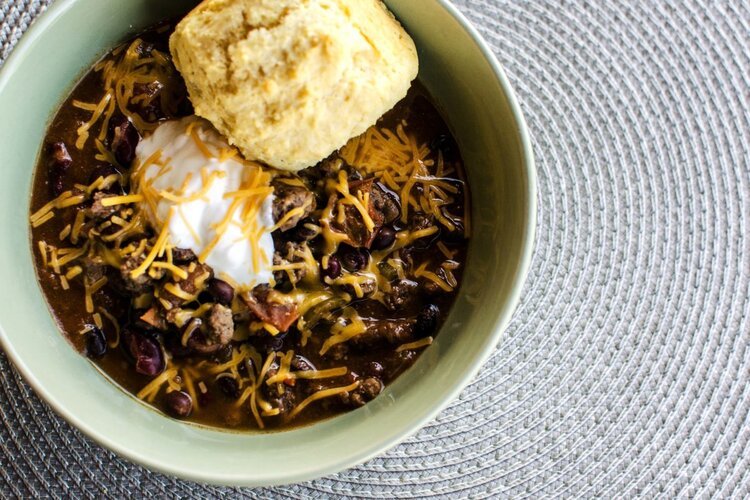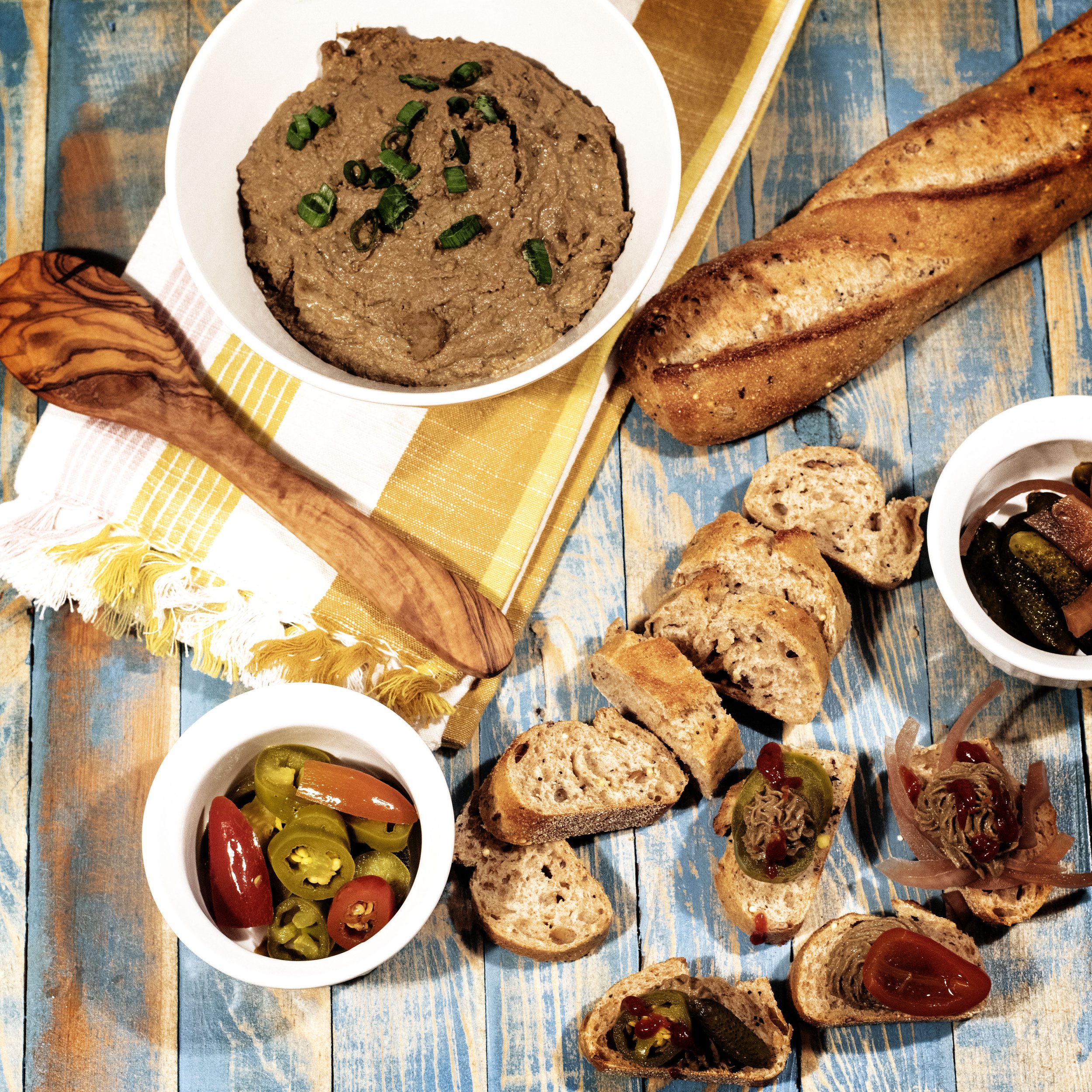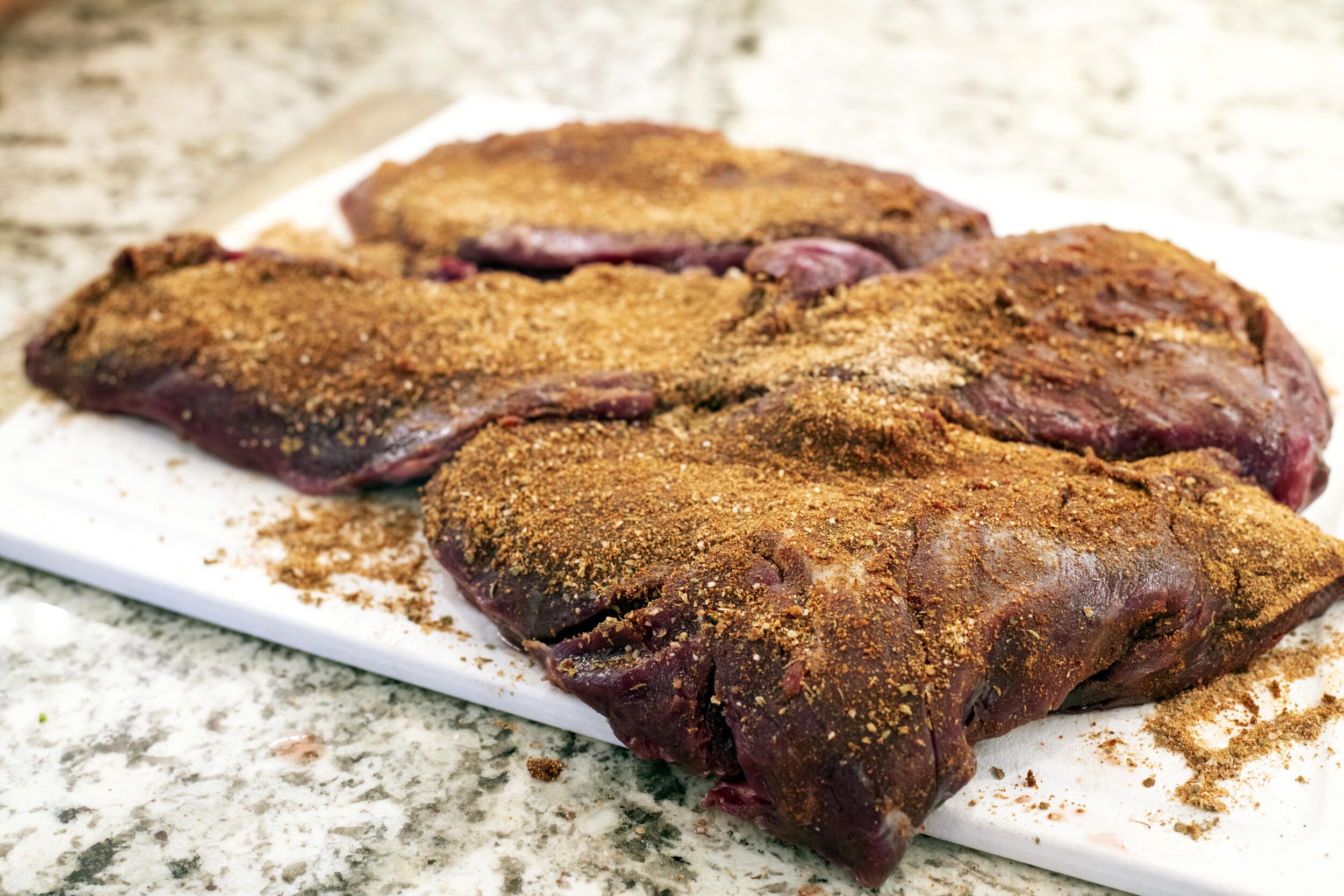Meaty pike skewers are marinated in zesty lemon and aromatic fresh rosemary, resulting in a hearty and rustic grilled fish perfect for serving at the next family barbeque night.
Salmon Burgers and Fresh Cut Fries!
Morel Mushroom and Asparagus Risotto
This Morel Mushroom and Asparagus Risotto was not just delicious to eat. It was also an adventure just to get the ingredients. I found these morel mushrooms on the North facing slope of a burn scar on my hometown mountain. The previous summer a fire had devastated much of the forest area. As many people do feel when natural disasters strike, the town felt helpless, afraid, filled with anger they were unable to direct, and at the end of it all just sadness.
Looking up at the charred, blackened shadow of where the forest trees once stood, I wasn’t interested in walking through the forest just to be reminded of the life that once filled the area. I wondered how long people would stay away.
A few weeks ago, I saw an Instagram post about morel mushrooms. These fungi emerge from the ground after their symbiotic partner, the tree, has died. After a fire, when nothing is left of a tree but the burnt base and naked branches, the morels sprout from the dark soils of the tree’s roots in order to reproduce. Burn scars are prime morel hunting country, and I had one right in my own backyard.
I had never hunted morel mushrooms before but looking online they seemed like a good starting point for fungi harvesting. Their distinctive look makes them the perfect beginner’s mushroom for hunting. More information on morel hunting can be found here: Morel Mushroom Hunting Tips.
Once I was walking around the burn, it took a while before I actually found any mushrooms. Like with the start of most hunting outings, I grew impatient and frustrated, thinking I was wasting my time, within the first five minutes. I always start there. But once the forest starts feeding you with its information and you block out the noise of your daily life, the purpose no longer becomes to find mushrooms. The purpose becomes to take in the moment around you: the slight smell of ash from the fire still filtering through the air, the rich, dark soil at your feet contrasted by emerging baby greens, the crows noisy discussing amongst each other somewhere in the distance, the wind meandering through the cracks of the burnt trees, and the taste of the light mountain breeze against your lips.
It also is that much better when you find morels!
I found about a pound of morels, which was the perfect amount for making this Morel Mushroom and Asparagus Risotto. Let’s get started cooking it!
Morel Mushroom and Asparagus Risotto
Risotto is a somewhat time-consuming meal, but I enjoy it. Like mushroom hunting, it is a time to unwind and just take a moment to yourself. It is not overly complicated to make, just requires a little patience and the engagement of your stirring muscles. To start, clean the morel mushrooms with water, removing all the dirt, and then slice into quarters.
In a small saucepan over low heat, warm a quart of vegetable stock. The stock should be kept at a simmer. You will use this for your risotto here in a bit.
In a large skillet or even a dutch oven, add two tablespoons of olive oil and a tablespoon of butter over medium heat. Once the butter has melted, add your morels and asparagus. I cut the asparagus into two- or three-inch pieces for this recipe. Saute the mushrooms and asparagus until just starting to turn tender, about five minutes. Remove from the skillet and set aside.
To the same skillet, add another two tablespoons of oil and one more tablespoon of butter. Add a medium size diced shallot and cook for two minutes. Pour in a cup of arborio rice and toast for another minute, stirring to keep it from browning too much. Add a few sprigs of fresh thyme. You can add the entire sprig and remove it after cooking, or just add the leaves. I just added the leaves.
Pour in a half cup of Marsala wine and let it simmer until completely evaporated. It is now time to start making the risotto! This part of the recipe takes between 12-17 minutes and is the relaxing part of the meal. Add between a quarter and half cup of the warm vegetable stock to the skillet. Ensure your heat is at a level where the liquid is just simmering and not boiling. You want the rice to slowly absorb the liquid and if the heat is too high the liquid will just burn off before the rice has a chance to work its magic.
Keep slowly stirring until the rice has absorbed all the liquid from the pan and then add another scoop full and keep stirring. Repeat this low and slow cooking method until the rice no longer is absorbing liquid. It should take the entire quart of vegetable stock. I have had times where I add another half cup of water to finish at the end, but not often. You will know the rice is finished when it is soft and chewy. There should also be a very light, starchy sauce surrounding the rice by the end. It shouldn’t be dried out like when you steam rice.
Once the rice is finished, add back in the morels and asparagus along with another tablespoon of butter for a little extra creaminess. Warm for another two to three minutes.
To plate up this delicious meal, add a heaping scoop of the Morel Mushroom and Asparagus Risotto to a bowl. Sprinkle fresh chopped parsley and some shaved Parmesan over top. Drizzle with a little olive oil or balsamic vinegar glaze if so desired. Season with some salt and fresh cracked pepper. And there you have it!
Happy (Mushroom) Hunting
Hello, World!
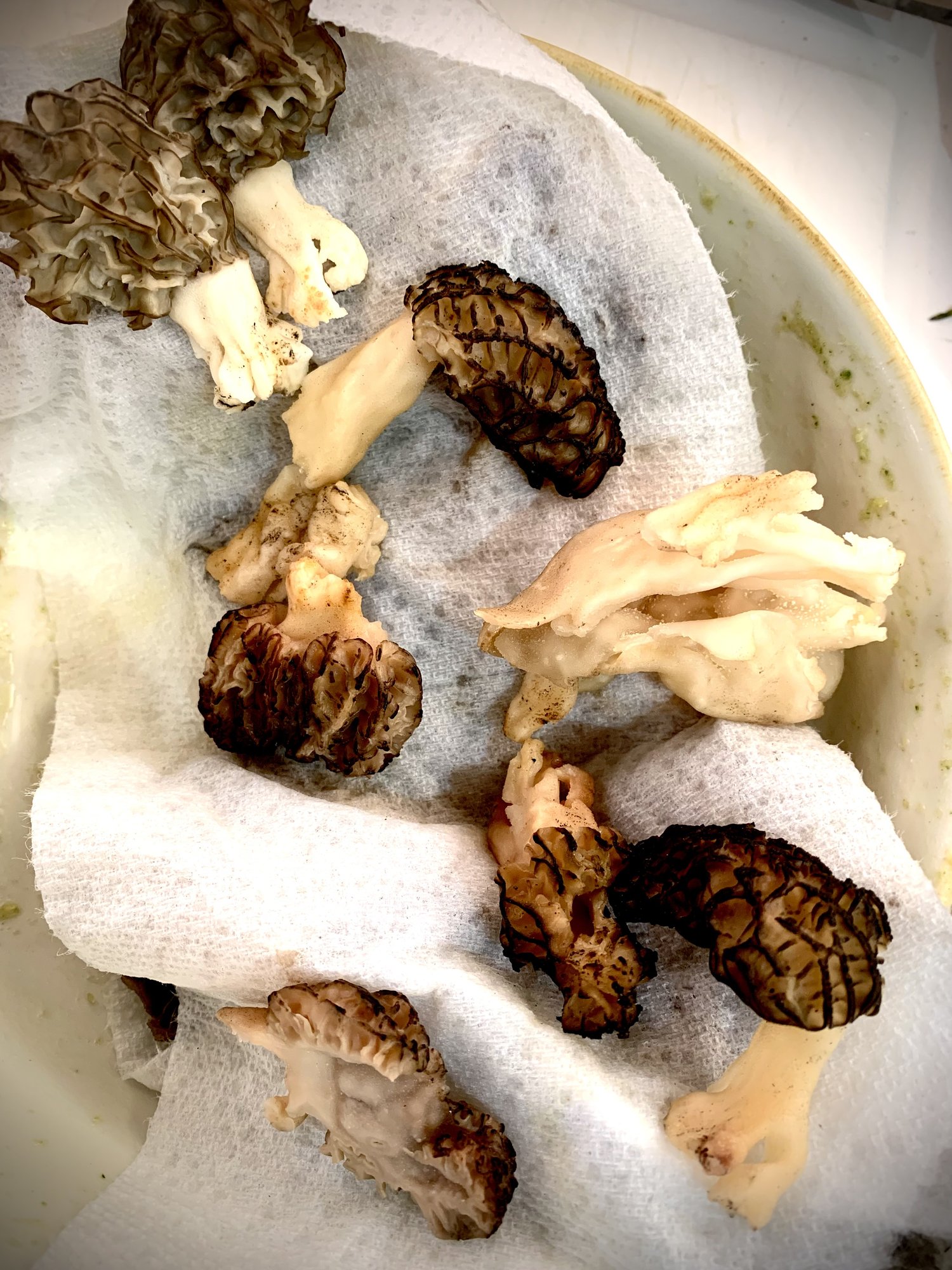
Morel Mushroom and Asparagus Risotto
Ingredients
- 1/2 pound fresh morel mushrooms, washed and quartered
- 1 pound asparagus, cut into 2 - 3 inch pieces
- 1 quart vegetable stock
- 1/4 cup olive oil
- 1/4 cup butter, cut into tablespoons
- 1 medium shallot, minced
- 1 cup arborio rice
- 1/2 cup Marsala wine
- 2 teaspoons fresh thyme
- Shaved Parmesan cheese
- Fresh parsley, chopped
- Salt and pepper to taste
- Optional garnishes: olive oil, balsamic vinegar glaze
Instructions
- In a small saucepan over low heat, warm a quart of vegetable stock This will be for building your risotto. Keep it warm while preparing the mushrooms and asparagus.
- In a large skillet or even a dutch oven, add two tablespoons of olive oil and a tablespoon of butter over medium heat. Once the butter has melted, add your morels and asparagus.
- Saute the mushrooms and asparagus until just starting to turn tender, about five minutes. Remove from the skillet and set aside.
- To the same skillet, add another two tablespoons of oil and one more tablespoon of butter. Add a medium size diced shallot and cook for two minutes.
- Pour in a cup of arborio rice and toast for another minute, stirring to keep it from browning too much. Add the fresh thyme leaves. Stir everything to coat in oil.
- Pour in a half cup of Marsala wine and let it simmer until completely evaporated.
- Add between a quarter and half cup of the warm vegetable stock to the skillet. Ensure your heat is at a level where the liquid is just simmering and not boiling. You want the rice to slowly absorb the liquid and if the heat is too high the liquid will just burn off before the rice has a chance to work its magic. Keep stirring often.
- Repeat this low and slow cooking method until the rice no longer is absorbing liquid. It should take the entire quart of vegetable stock. Sometimes additional water needs to added if the rice isn't quite soft and chewy after using all the vegetable stock.
- Once the rice is finished, add back in the morels and asparagus along with another tablespoon of butter for a little extra creaminess. Warm for another two to three minutes.
- To plate up this delicious meal, add a heaping scoop of the Morel Mushroom and Asparagus Risotto to a bowl. Sprinkle fresh chopped parsley and some shaved Parmesan over top. Drizzle with a little olive oil or balsamic vinegar glaze if so desired. Season with some salt and fresh cracked pepper
Wild Game Bone Broth French Onion Soup
Wild Game Bone Broth French Onion Soup. After the sun has pulled the covers up and tucked itself in for the nigh and the cold starts to set in, does anything sound better than warm soup? I don’t think I feel happier and cozier than when I have my hands wrapped around a steaming bowl of French onion soup topped with gooey, melty gruyere cheese and homemade wild game bone broth.
Wild Game Bone Broth French Onion Soup
French onion soup is an OLD dish. Like think 8,000 years old. There are many different versions of how it first came around, but my favorite is the one where King Louis XV returns from deer hunting to bare cupboards. He rounds up some onions, butter, and champagne (which seems odd that his cupboards are bare, but champagne is around, but anyway), throws it all in a pot, and voila, French onion soup is born.
French onion soup was commonly considered the food of the poor because onions were cheap, easy to grow, and plentiful throughout Europe. The soup became popular in the 1960s in America along with the nation-wide trend of French cuisine in general.
To me, if French onion soup is the food of the poor, I don’t want to be rich. It’s one of my favorite meals. The ingredients are simple and easy to find, but the flavor developed from simply simmering caramelized onions in silky bone broth is downright amazing!
So, without wasting more time, let’s make Wild Game Bone Both French Onion Soup!
The Wild Game Bone Broth
You can make this recipe with store-bought beef broth, which is fine, but this is a wild game website, so I am going to share really quick (like the condensed, superfast version) how I make homemade wild game bone broth. I make a huge batch at one time from any of the bones I have in the freezer. Many times, the broth will be a combination of elk, deer, and pronghorn bones.
I roast the bones in a 400-degree Fahrenheit oven for one hour. I also do two or three onions, just cut in half and you don’t even have to remove the skin, and a couple of big chunks of ginger, I don’t even peel it.
After the bones are roasted, I put them, the onions, ginger, about six carrots, a bunch of celery, a couple of star anise pods, and a handful of whole cloves into a large stock pot. I cover everything with water, so this could end up being up to 24 cups of water if the pot is large like mine, and let it start simmering for hours. When I say hours, I mean like six. I reduce the liquid by about three quarters. Pour through a fine mesh sieve and scrape any fat from the top.
I don’t add salt to my bone broth. I just salt it when I use it so I can get it the way I like. Also, because it is so concentrated after hours of simmering, it doesn’t take up much room in the freezer. I freeze it in little pint-sized containers and then when I use for a recipe later, I add back in the water. So, for a pint of broth, I would add eight to twelve cups of water back in, depending on what I am doing.
Let’s Make French Onion Soup
Now that the broth is ready, it is time to start the onions. To a large skillet over medium heat, add a couple of tablespoons of olive oil, enough to coat the entire base of a ceramic dutch oven, and a tablespoon of butter. Once the butter is melted, add the onions. I slice the onion into long strips for this soup.
Spread the onions out and make sure they are coated in the oil. Let them cook for ten minutes, stirring often to keep them from sticking to the pan or burning. If they are cooking too quickly, you may need to reduce the heat a little. You are looking for a slow caramelization here.
After ten minutes, sprinkle a tablespoon of salt over the onions to develop even more flavor. I also add a teaspoon of sugar. It helps with caramelizing. Cook for twenty minutes more.
Once the onions are golden, and caramel-y, and smell like heaven, they are ready. Deglaze the pan with a cup of wine, red or white will work here, and be sure to scrape all that flavorful goodness from the bottom of the pot.
Add the pint of reduce wild game bone broth and eight to twelve cups of water. Bring to a gentle boil, and we will add even more flavor to this dish! Add two tablespoons of Worcestershire sauce, a tablespoon of Italian seasoning, and salt and pepper to taste.
Reduce the mixture for thirty minutes on a simmer. Add a quarter cup of sherry.
While your soup is doing its thing, toast sliced pieces of French baguette in the oven. I toast them under the broiler for five minutes. If you brush them with a little butter or olive oil first, you will get a beautiful, crunchy golden crust.
It’s time for the fun part: melting the cheese. Fill an oven safe ramekin with a cup or two of the French onion soup base. Nestle a few pieces of the toasted French bread into the soup, and then top it with shredded gruyere cheese. I do a ramekin per person.
Place the ramekins in the oven at 350 degrees for about ten minutes. The cheese should be melted and slightly browned (cue drool), and the broth slightly boiling. Aaaannnndddd…it’s time to eat!
Happy Hunting!
If You Like This Recipe, You Might Also Like…
Deer Liver Whiskey Apple Pate
So, I did an offal thing. It was completely out of character for me. I made deer liver pate. Every year while people are cleaning their deer I comment how “someday” I am going to use the organs from a harvest and make…something.
“When the blood in your veins returns to the sea, and the earth in your bones returns to the ground, perhaps then you will remember that this land does not belong to you, it is you who belongs to this land.” ~ Native American quote
I have had deer heart once before. But it wasn’t mine. And I didn’t prepare it. It was surprisingly good. That is about all of the adventure I have embarked on when it comes to organ meat, but I have read a lot about keeping organs and the benefits of their consumption.
Traditionally, hunters never discarded the organs. Organs were harvested and prepared for their nutritional benefits. They are excellent sources of minerals and vitamins. But don’t take my word for it. Here’s an article with lots of information about the benefits of organs.
I heard this thing recently, and this could all be rumor but I am going to share it anyway, that James Blunt, you know the celebrity, went on an all meat diet and ended up developing scurvy, the “sailor’s disease.” Scurvy is incredibly rare, but one way to develop it is to become a carnivore.
Scurvy is basically when your body becomes depleted of Vitamin C and you develop a vast collection of issues such as weakness, fatigue, wounds that don’t heal up properly, and other stuff. It doesn’t sound fun. James Blunt cured his scurvy by consuming orange juice until he developed acid reflux.
So, the moral of the story seems to be that being a carnivore doesn’t work if you’re a human. Or does it? Historically, there are groups of humans who survived solely eating meat. The best example is the Arctic Native American tribes the Inuit. The arctic tundra is not a suitable landscape for growing crops, so the Inuit diet consisted of fish and the mammals they hunt, including seals, walruses, and whales.
Obviously they do not develop scurvy or the other illnesses associated with being a carnivore. How is this possible? While many things most likely factor into the equation, there are two habits the Inuit engage in that researchers believe keep them healthy and able to survive of a solely meat-based diet.
First, the Inuit eat most of their meat raw, both mammals and fish, and this is thought to sustain more of the vitamins and minerals contained within the meat. Second, they eat the organs. If you want to know more about the Inuit and their all meat diet, this is a great book: My Life with the Eskimo.
So, in conclusion, I would like to send a message out to James Blunt. Next time you go full carnivore eat your organs!
Now that’s out of the way, let’s make this venison liver pate.
Pate was much easier to make than I initially thought. There are lots of different ways to make your liver concoction. You can vary which type of liver you use, what type of spices or vegetables you mix in, and even the fat you add at the end can be different. It’s basically a choose your own adventure with pate.
The key to a successful pate is to remove some of the rich “bloody” taste that liver is known for. Just to give you an idea if you haven’t tried liver, it has a strong iron taste. It is very distinct and lies somewhere between metal and blood. It is so distinct, you will always recognize it in a dish no matter how little is used. If you asked me what iron tasted like, I don’t know that I could find the words to accurately describe it, but if you had me taste something that is rich in iron, like liver, I could immediately pick that flavor out. While you can’t fully remove this definable characteristic of liver, you can lighten it. You want a pate that is reminiscent of the liver flavor. Achieving this is quite easy. I soaked the liver overnight in a mixture of salt and water. I used four cups of water and two tablespoons of salt.
In the morning, the liver had a more muted color. I thoroughly washed the liver, removing any access blood from it, and then cleaned off any thing that didn’t look edible, such as arteries or connective tissues. Just make it pretty.
Heat up a large, heavy bottomed skillet or a dutch oven. I used a very large cast iron skillet for my pate. Cook up five or six slices of bacon until crispy. Pull the bacon and set aside, but reserve the fat in the pan to use for sautéing your vegetables.
To your hot bacon grease, add one diced onion, four diced carrots, and 4 diced celery stalks. Also add in one chopped apple. It isn’t important the size you dice up your vegetables to, since you will ultimately puree everything, but try to keep the size uniform so your vegetables will cook evenly.
Cook the vegetables for about five minutes and then add the chopped liver. Season with salt, pepper, and oregano. Cook until the liver is cooked through, about ten to fifteen more minutes.
Drizzle in the cup of whiskey at this point and let things reduce for five to ten minutes. The mixture should be thick and the wine along with the starches from the vegetables should create a creamy coating over everything.
Alright, it’s time to turn this pile of vegetables and liver into pate! Be careful with this next step, as things tend to be hot and steamy. Fill a food processor with the liver mixture. I had to add about half the mixture, blend until it broke down into a paste, and then add the second half. If you have a larger food processor you may be able to fit the entire pan in one large batch.
Don’t forget to add your bacon back into the pate mixture at this point. I just dropped the pieces in whole and let them blend down, much to the dismay of the dogs who were very certain the bacon was going to be theirs’.
Grind until things are smooth. Slowly drizzle in your cup of heavy cream. If you are looking for a dairy free option you can use a can of coconut cream and it works nicely too. The cream really changes the consistency of the entire dish. It creates a beautifully smooth, creamy texture that almost melts in your mouth.
Afterwards, put the pate in the fridge to cool for at least two hours. It tastes best cold. You can preserve it if you aren’t going to use it immediately, like say you are making it for your party tomorrow, by pouring melted butter over the top. This creates a nice seal on top.
Alright, let’s serve this pate up! This was my first time eating pate. It was actually my first time eating liver ever. I will admit, it took me a few bites to wrap my head around it. It is rich! It is earthy! It is…a lot.
One thing I learned is how you serve pate can change everything. Just pate on a little slice of bread isn’t my most favorite presentation. It just tasted like liver. Which isn’t a bad thing if you are a liver fan. My parents, having grown up on liver and onions, loved it just plain. I needed a little more bling for my pate.
So, to plate up your pate, first toast a thin slice of baguette. Add a little butter to your slice. Smother some pate on top. Finally, garnish with a pickled vegetable of your choice. The most popular is a cornichon pickle. My favorite was pickled red onion. Other options are pickled jalapenos, capers, cucumbers, pickled beets, or radish slices. Another item that made it that much better was to add a drop of a mustard based hot sauce like my all-time favorite from the Caribbean island of Grenada.
I am curious, what do you like to top your pate with? And what is your favorite liver to use?
Anyway,
Happy Hunting!
Bomb Bear Burrito
For the past few weeks I have been thinking over and over in my head how to best describe bear meat. I have made a couple recipes with the intention of sharing with family and friends as an introduction to bear meat, and have felt their palpable resistance to giving it a try. Offer up a slice of deer or elk steak, people will most likely grab it from the plate with little hesitation. Share a new pronghorn recipe with a wild game greenhorn, and the pause is brief before they bite in. Say you’re latest recipe has bear meat, and you’re likely to hear crickets.
Once people’s initial shock has passed, the first question is usually: “Well, what does it taste like?” And that is a hard question to answer.
My gut reaction to the question is to simple say: “Pork.” And as soon as the word leaves my mouth it feels incorrect. So I go into correction mode.
“Well, it kind of tastes like pork. But the texture is nothing like pork. And actually it doesn’t taste like pork.”
So, that answers no one’s questions and we are back to square one. What does bear meat taste like?
Some of it depends on the region and time of year the bear is harvested in. The diet of a bear varies not only by the season, but also the terrain. At certain times of the year, bears’ diets can be up to 90% vegetation based from shrubs, brush, grasses, to berries, roots, and bulbs. They also fancy insects, fish, and other meats. So, needless to say, what they are eating is highly varied and this can affect the way the meat tastes.
The other factor affecting the meat’s taste and texture is the fat content of the animal. Bears in general are a fatty animal, and their meat is often described as greasy or oily. A spring bear emerging from winter’s hibernation is obviously much leaner than a fall bear ready for the big nap, so the season a bear is harvested can also affect the taste and texture of the bear.
With those factors set aside, the most basic way to describe the taste of bear meat is it tastes like bear meat. It’s a unique experience. It slightly similar to domesticated beef in texture, but the meat grains are longer and a bit coarser.
Bear meat has a relatively mild flavor but also a touch of sweetness you won’t find in any other meat. It is a darker meat than beef or even deer or elk, but doesn’t have the slight iron taste you experience with dark red meats like from duck or geese.
Starting to sound like a meat you would like to experience? Here is a recipe for a Bomb Bear Burrito that is the perfect introduction to bear meat.
Preparing the Bear Meat
While there are many cooking methods available for wild game that conclude with delicious results, my favorite method for bear is low and slow. Slow cooking bear meat allows the flavors to really meld together but also results in a delightfully tender texture.
For this Bomb Bear Burrito, I rubbed the bear with a very simple spice blend: cumin, coriander, chili powder, cayenne, oregano, salt, garlic powder, and onion powder. I used a tablespoon of each and rubbed it on both sides of my chucks of bear. From we head to the crock pot.
Place the seasoned bear chunks in the crock pot and pour over about two cups of vegetable stock. You could also use chicken or beef stock if that is what you have on hand. Water would also work, things just might be a little less flavorful. Cover the pot, set it to low, and let the crock pot work its magic for seven hours.
During the seven hour wait for my crock pot bear meat, I usually do things like go to work, clean the bathroom, go grocery shopping, work in the yard, eat snacks (but not so many snacks I get to full for dinner), and watch Netflix marathons of long forgotten TV series from my childhood. Basically, the nice thing about the crock pot is it frees you up for the other important things going on in your life.
Fast forward to seven hours in the future and the bear meat should be tender, juicy, and flavor soaked. Pull the meat from the crock pot and place on a cutting board. Remove the liquid from the crock pot. Shred the bear meat into bite size pieces and return to the crock pot.
The Guava Barbeque Sauce
This sweet and tangy barbeque sauce is the perfect pairing for bear meat. Like bear meat, it has this subtle sweetness to it that you can taste but it doesn’t overwhelm the entire profile of the dish. It is also extremely easy to pull together and would be great over pork or shredded beef as well in other eating situations.
To start, in a medium sauce pan over medium heat add a cup of diced up guava paste. To the paste, pour over a 1/3 cup of apple cider vinegar and a quarter cup of whiskey (your choice there on the brand). Also add in three tablespoons of tomato paste. Stir everything the best you can, it might be a bit difficult at this point since it takes a bit for the guava paste to break down, but just do your best.
Mix in a tablespoon of Worcestershire sauce, a tablespoon of coconut aminos (or soy sauce if you don’t have coconut aminos and aren’t interested in adding them to your pantry), two teaspoons of ground ginger and cinnamon, a teaspoon of garlic powder, a teaspoon of ground mustard, and salt and pepper to taste.
Let the guava barbeque sauce simmer for five minutes so it will breakdown the guava paste and everything can be mixed to a smooth texture. Then, pour the sauce over the shredded bear meat in the crock pot, turn the pot to high, and let things warm while you prepare the rest of the ingredients for this Bomb Bear Burrito.
The Caramelized Onions
Continuing with the theme of slightly sweet, next on the agenda is to make some caramelized onions. Before we go through the very simple task of caramelizing onions I want to first say that I love them. They are fantastic! Sweet and just a little bit salty, caramelized onions make everything better. Having a bad day? Boss getting ya down? Kids climbing the walls? Make some caramelized onions and things will suddenly be better. Life can suddenly be viewed through rose colored glasses, and all it took was some slow cooked, caramelized onions.
Okay, so enough on that weird tangent, in a decent sized pan over medium heat add a few tablespoons of olive oil. While the oil is heating, thinly slice two large yellow onions. Place the onions in the pan, coat them in the oil, sprinkle with a teaspoon or so of salt, and let them slow cook, stirring occasionally for five minutes.
At the five minute mark, sprinkle over a tablespoon of sugar and add a quarter cup of balsamic vinegar. Stir everything and let them continue to slow cook. You want the onions to be slowly cooking but the heat to not be so high they are burning. They should start to brown because of time, not too much heat. After another five minutes or possibly a little more, you should have a beautiful, browned pile of caramelized onions.
The Cheese Sauce
This creamy, silky cheese sauce is quick and easy to make. In a medium sauce pan, add two tablespoons of olive oil and a tablespoon of butter. Over medium heat, melt the butter. Once it is melted down add a minced shallot to the pan.
Cook the shallots for three to four minutes then sprinkle three tablespoons of flour over the butter and shallot. Whisk the flour into the oils until a mellow yellow paste is formed. Slowly whisk in two cups of vegetable (or chicken if that is what you have on hand) into the paste. Whisk until the paste has completely broken down and dissolved into the liquid.
Bring the liquid to a low boil so it will thicken. Once the sauce has started to thicken it is time to season the sauce. Add a teaspoon cumin, garlic powder, and half a teaspoon of salt. Also add in the half cup of sour cream.
For this recipe I used a quesadilla melting cheese. Quesadilla melting cheese is usually a little more dense in texture than other cheeses and less salty. It makes for a cheesy but creamy sauce. Diced up about a cup of the melting cheese and continue to stir the sauce until the cheese is fully incorporated and the sauce is thick and silky.
Compiling the Bomb Bear Burrito
Pile a large helping, I am thinking it probably works out to about a cup, of the guava barbeque sauce shredded bear meat onto the burrito size flour tortilla. Add a few spoonful scoops of the caramelized onions on top of the bear meat. Now, burrito fold that bear up.
Heat the skillet used for the caramelized onions to high heat. Place the burrito into the skillet seam side down and cook for one minute. Flip the burrito and cook the other side of another minute.
Plate the burrito and pour a healthy serving of the sour cream cheese sauce over the burrito.
And that is it for this Bomb Bear Burrito! Time to dig in for a sweet, savory, and cheesy burrito. Enjoy!
Happy Hunting!
Looking for other fun bear recipes to try? Check out this Barbacoa Bear Bowl!
Hello, World!
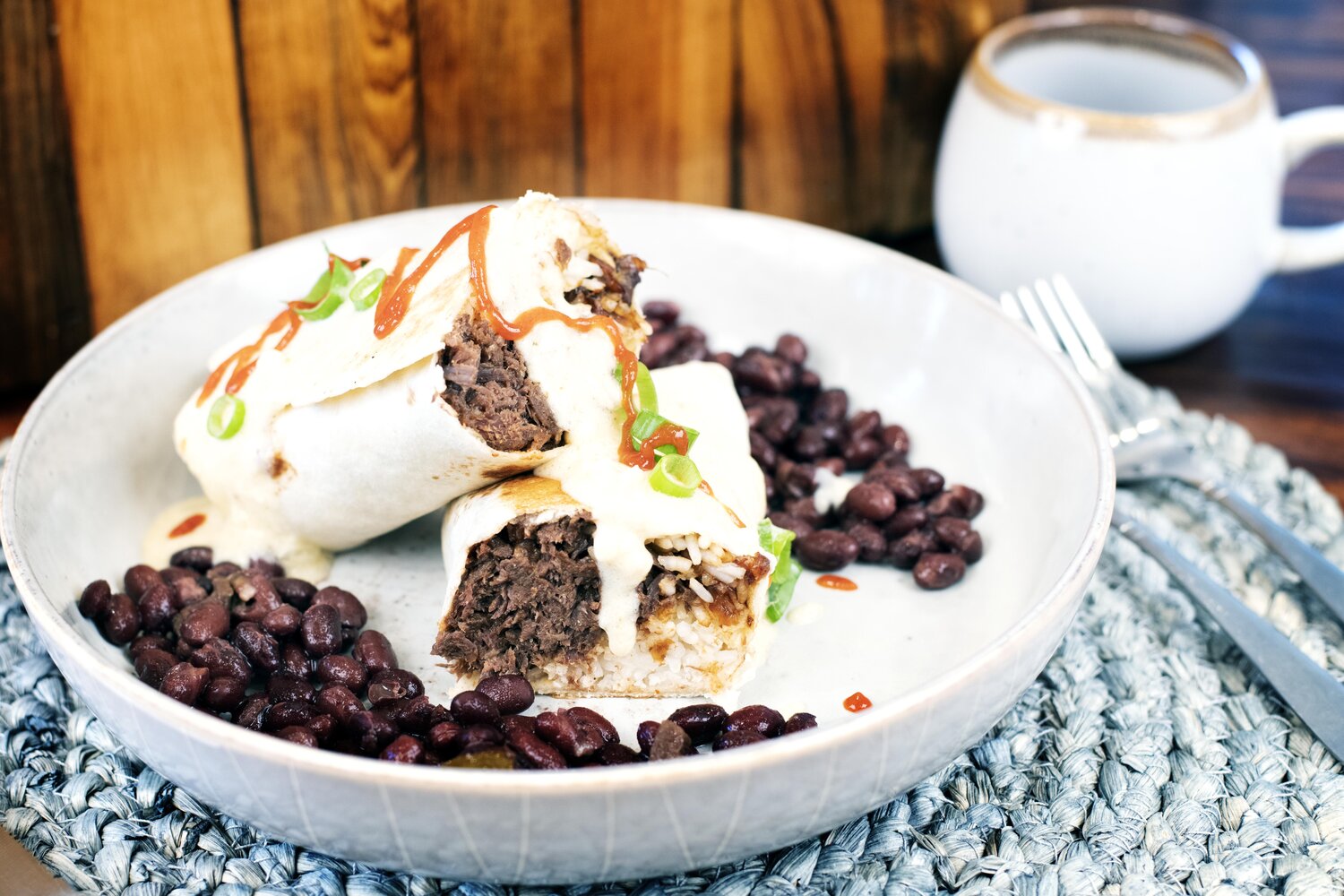
Bomb Bear Burrito
Ingredients
- 2 to three pounds of bear meat chunks (or deer, elk, pronghorn, moose, beef, extra)
- 1 tablespoon cumin
- 1 tablespoon coriander
- 1 tablespoon chili powder
- 1 tablespoon cayenne
- 1 tablespoon oregano
- 1 tablespoon garlic powder
- 1 tablespoon onion powder
- 1 tablespoon salt
- 2 cups vegetable stock
- 1 cup guava paste, diced
- 1/3 cup apple cider vinegar
- 1/4 cup whiskey
- 1 tablespoon Worcestershire sauce
- 1 tablespoon coconut aminos
- 1 teaspoon ground ginger
- 1 teaspoon garlic powder
- 1 teaspoon cinnamon
- 1 teaspoon ground mustard seed
- Salt and pepper to taste
- 2 large yellow onions, thinly sliced
- 3 tablespoons olive oil
- 1 teaspoon salt
- 1/4 cup balsamic vinegar
- 1 teaspoon sugar
- 1 tablespoon butter
- 2 tablespoons olive oil
- 1 medium shallot, minced
- 3 tablespoons flour
- 2 cups vegetable stock
- 1 teaspoon cumin
- 1 teaspoon garlic powder
- 1/2 teaspoon salt
- 1/2 cup sour cream
- 1 cup quesadilla melting cheese
Instructions
- Rub the bear chunks in the seasoning spices: the tablespoon of cumin, coriander, chili powder, cayenne, oregano, garlic powder, onion powder, and salt.
- Place the seasoned bear chunks in a crock pot and pour in two cups of vegetable stock.
- Place the lid over the pot and set to low. Allow to slow cook for seven hours.
- Once the bear meat is tender and cooked through, remove from pot and shred. Discard cooking liquid and return shredded bear to the crock pot.
- To make the guava barbeque sauce, in a medium sauce pan, add the diced guava paste.
- Heat the paste over medium heat and add in apple cider vinegar and quarter cup of whiskey. Stir to break down the guava paste.
- Once the paste has incorporated with the vinegar and whiskey, add in a tablespoon of Worcestershire sauce, tablespoon of coconut aminos, and teaspoon each of ground ginger, garlic powder, cinnamon, and ground mustard seed.
- Season to taste with the salt and black pepper.
- Pour the finished guava barbeque sauce over the shredded bear meat and allow the meat to heat up in crock pot until the rest of the burrito ingredients are finished.
- In a large skillet over medium heat, add three tablespoons of olive oil and the two large thinly sliced onions. Allow the cook down five minutes, stirring to keep the onions from burning.
- At the five minute mark, add the sugar and balsamic vinegar. Continue cooking and stirring for at least five more minutes, longer if the onions are not as caramelized as you desire.
- In a medium saucepan over medium heat, melt a tablespoon of butter with two tablespoons of olive oil. Add the minced shallot and cook for three to four minutes.
- Sprinkle the flour over the shallots, and whisk until a light paste forms. Add in the two cups of vegetable stock and whisk until paste is completely dissolved.
- Let mixture come to a light boil and slightly thicken.
- Add in the cumin, garlic powder, and salt.
- Stir in the half cup of sour cream and the cup of quesadilla melting cheese. Stir until everything is melted together and smooth.
- To plate the burrito, add a cup or two of the guava bear meat to the tortilla. Top with the caramelized onions and fold closed.
- In the onion skillet over high heat, place the burrito seam side down and cook for one minute. Flip and cook a minute more.
- Drench the burrito in the sour cream cheese sauce and dig in to this Bomb Bear Burrito.
Manila Clam Pasta on the Grill
Manila clams are actually an imposter to the Washington ocean ecosystem. They are native to Japan and were accidentally introduced to the salty seas of the Washington coast line in oyster shipments. They can be found all along the Pacific coast line of the United States, and are actually a welcome addition to the waters because they are delicious! The clams are identified by their oval shaped shells with heavy ridge lines running the horizontal length of the shell.
Pronghorn Pumpkin Beer Chili
Chipotle Apricot Rum Chicken: Dutch Oven Dinner
I was so happy come Saturday evening to have a spicy, warm, rich dutch oven dinner ready to share with the hunting camp. This recipe takes a bit of time to cook, but is worth the wait and is very simple to put together. It is perfect for a chilly evening and a tired, maybe even exhausted, camp full of people.
Guinness Elk Stew
Dutch Oven Apple Pie
Dutch Oven Pineapple Upside Cake
Elk Shepherds Pie: Dutch Oven
Elk Steak Smothered in Blueberry Balsamic Reduction and Gorgonzola Cream Sauce!!! Rich and Delicious!
Whiskey Elk Backstrap
Dutch Oven Chicken Cordon Bleu
Pheasant Meatballs with Brandy Apples and Onions
Asian Style Elk Meatballs: A Perfect Party Appetizer
I am not always the best pre-planner. If I am headed on vacation, I am the one packing my bags thirty minutes before we are scheduled to leave. I tend to forget essentials, you know, like my tooth brush. I do not know why I have to wait until thirty minutes before our scheduled departure to start preparing for my trip, but I do it every time. And every time, as I am realizing I don't have any clean socks to pack, because that would require a pre-check of my dresser drawers to ensure there are socks available for my trip, I curse myself for procrastinating. You would think I would learn my lesson. Arriving at your destination without pants to wear can be quite unfortunate. But every vacation, no matter what, I still find myself packing that bag thirty minutes before jumping in the car and hastily roaring away, most likely with a pair of dirty socks, no toothbrush, and pant-less.
"I wanted to be a skinny little ballerina but I was a voluptuous little Italian girl whose dad had meatballs on the table every night." ~ Lady Gaga
This incredible skill of procrastination is also useful in other situations. This past New Year's Eve, I was invited to a late night celebration. I was invited well over a week in advance, and was told to bring three simple things: myself, a drink to share, and an appetizer dish to share. Guess what was ready with an hour before party time? Nothing. Not my drink to share, not my appetizer dish, and certainly not myself.
Realizing people would probably not care if I stopped at the store and grabbed a bottle of some drink to share and that I was dressed like a slob (with dirty socks of course), I did think people would notice if I arrived with no appetizer in hand. I contemplated buying one of those pre-made vegetable or meat and cheese trays, but I figured my fellow procrastinators would also devise this plan and arrive with the same appetizer.
I opened my refrigerator in search of something to throw together, and luck would have it, there was a pack of elk chunk waiting to become my quick, throw together New Year's Eve appetizer. I quickly ran the chunk through my meat grinder. It resulted in about a pound of ground elk. To the ground elk, I added a cup of panko bread crumbs, some fresh chopped parsley, and a little nutmeg. I also seasoned generously with salt and pepper. I also added in one beaten egg and two tablespoons of milk.
I find the best tactic for mixing meatballs is to just dig right in with your hands. This gets everything incorporated really thoroughly. Also, it allows you to test the consistency of the meatballs. If the meatballs feel too wet and things aren't really sticking together, add more panko bread crumbs. If things feel to dry, add in more milk.
Since this was a quick throw together appetizer, I used what was available in my pantry to make my meatballs. If you don't have, or maybe you don't like, panko bread crumbs, traditional bread crumbs will also work. Also, I don't always have fresh parsley on hand. I actually never have it on hand, but for some reason on this particular evening I did. If you don't have fresh parsley, dried would also work. You would only need a tablespoon of dried parsley instead of a quarter cup like with the fresh.
Roll the meatballs into balls using about a tablespoon of the meat mixture. Place them on an ungreased baking sheet. For easier clean-up, line the sheet with aluminum foil. Bake the meatballs in a 400 degree oven for about 12 minutes. The meatballs should be slightly browned and your kitchen should smell delicious!
While the meatballs are roasting away, pull out a crockpot. Set the crockpot on low heat.
To the pot, add 3/4 to 1 cup of hoisin sauce. I started with 3/4 of a cup and then added more at the end of I wanted more of the hoisin flavor to stand out. A beautiful dark amber color, hoisin is a sweet and salty sauce commonly used in Chinese cuisine. It is a pungent sauce packed with a ton of flavor, so start with less and you can always add more.
To the hoisin, add one tablespoon of soy sauce, a teaspoon of sesame seed oil, two cloves of minced garlic, and a teaspoon of ground ginger. To help liven up the flavor of the spices in the hoisin sauce, add a tablespoon or two of rice wine vinegar. Give everything a stir and a quick taste. The sauce should taste salty and a bit spicy. Now it is time develop the sweetness of this sauce. I always taste things before I start adding my sweetener to see where things are at. This is important with the hoisin because it also adds sweetness to the dish, and you don't want the meatballs tasting like lollipops! Anyway, slowly add the honey in a drizzle at a time, tasting as you go, until the sauce is where you want it. If you desire a bit more salt, add a little more soy sauce. If you want more hoisin flavor, drizzle some more of that in. I ended up with about a tablespoon of honey at the end.
After the meatballs are done cooking, add them to the hoisin sauce, making sure to coat all the meatballs with the sauce, and you are ready to party! I took the entire crockpot to the gathering with me, this way everything stayed nice and warm. To serve the meatballs, sprinkle a few sesame seeds on top.
Meatballs are a great party appetizer. A pound of meat and a few simple ingredients make a deliciously quick treat. They can be served using only toothpicks, so there is no need for utensils or plates. They can also be made in advance and then just added to the crock-pot to heat back up.
These salty and sweet Asian-style meatballs received lots of praise at the party, and no one suspected they were a product of procrastination.
Happy Hunting!
Homemade Pheasant Stock
"Be worthy of your game." ~ George Bird Evans
Learning to process game meat has been an eye opening experience. It is a challenging and ever-evolving labor. Cleaning a harvest is different, not only for different groups of animals, but even for different species within a specific subgroup of animals. For example, it is obvious that a fish is cleaned differently than a duck, but it isn't always obvious that a duck may be cleaned differently than a goose, or even another species of duck. Cleaning also varies on how you plan to prepare or use the animal. I feel I have only touched on the surface of cleaning animals.
Cleaning is just the beginning step of processing game meat too. Storing and preserving meat is an entirely different story. And not to mention learning how to use different parts of the animal! We often hear stories of how Native Americans used every part of an animal. Meat was obviously processed and eaten, but hides or feathers were used for shelter creation or clothing, bones could be constructed into tools or weapons, and tendons or sinew could be used to create thread or string. Of course, those few examples only brush on the surface of how many parts of an animal are useful.
Utilizing the entire animal was definitely a survival tactic for Native Americans, and as a modern day hunter, that drive for survival isn't quite the same. However, many hunters strive to use as much of an animal as possible. Whether this desire comes from a simple curiosity as to what you can come up with to use what you have at hand, or is from a deeper desire to use every part of the animal as a form of respect, there are limitless possibilities on what to create or how to utilize an animal in its entirety, and it is definitely a learning process.
So, while this might be a small step in terms of all the possible things I could use a pheasant for, it is a first step and I enjoyed trying something new with a different part of the bird. After cleaning all the meat from the pheasant, I saved the carcass and made a simple pheasant stock. While I was excited to find a use for the leftover bones of my pheasant harvest, my primary drive for creating a pheasant stock developed from a nagging feeling I got when using chicken stock in my pheasant recipes. For some reason, it bothered me when I would create a soup or sauce recipe for my pheasant meal, but had to use chicken stock as the base. It seemed silly. So, I made a small batch of pheasant stock from the carcass and can now use that as the base for whatever pheasant recipe I work on next.
For the stock, a few simple ingredients are necessary to help develop a deeper flavor profile. Aside from the pheasant carcass, you will need carrots, celery, and onion. I used around four medium sized carrots, three stalks of celery, and two medium sized onions. You could also add a few cloves of garlic. To create a little uniqueness in my stock, I also added in a four inch piece of whole ginger root.
Preheat the oven to 400 Fahrenheit and roast the pheasant carcass, celery, carrots, onion, and ginger root for 20 minutes. There is no need to cut anything up or do any type of prep work before roasting. The only step I took was the cut the onions in half. I did not peel the carrots or even remove the onion skin. If I had added garlic to this stock, I would have roasted the cloves whole as well.
Once the vegetables and pheasant are done roasting, transfer everything to a large pot. I did remove some of the skin from the ginger root before adding it to the pot, but that was about it. I left the onions whole and broke the celery in half so it would fit in the pot, but other than that not much work to be done! At this point, toss in a couple of bay leaves and add enough water to the pot to cover everything by about two inches. The amount of water needed will vary based on the size of your pot, but it should be somewhere between eight and twelve cups. I used ten for my pot. Heat the pot over a medium heat and watch until the water starts to boil. Once it boils, cover the pot and reduce the heat to a simmer. Let the stock simmer for a few hours, checking occasionally to make sure there is still enough liquid in the pot and that the pot is still just simmering and not boiling. I let my stock simmer for about four hours. The liquid reduced from ten cups to eight by the end of the cooking time.
If you are interested in creating a little bit of a different flavor profile for your pheasant stock, instead of using onions you could substitute leeks. You could also add fennel for a hint of licorice. Herbs can also be infused into the stock, such as thyme, sage, or basil. Strain the entire pot through a fine mesh colander, and discard all the vegetables and carcass. Allow the liquid to cool. In the end, the stock should be a beautiful auburn color and have a mild savory flavor.
I plan on using my stock within the next couple of days, so I poured it into mason jars and stuck it in the fridge. It should last in the fridge for about five days. Canning the stock is another option; however the process for cooking is a bit different. I prefer to freeze homemade stock that I am not going to use. I put it in a large Tupperware container and just pop it in the freezer. It will last indefinitely in the freezer.
This stock has a hint of the richness from the pheasant bones and also a clean, fresh taste from the vegetables. It is not salty, which took me a minute to get used to. When using store bought chicken stock, the stock is salted and, for me, that is the main flavor that stands out. This pheasant stock is a base starting point for any sauces, broths, or soups you might create with it. Think of the stock as a building block that will enhance and develop flavor in your dish. This recipe allows you to extract the umami (one of the five basic tastes) to use as an ingredient from a bird carcass or other bones. It also gives a little more reward to yourself and the animal that provided for you.
Happy Hunting!
Coconut Pheasant Soup
”All really wild scenery is attractive. The true hunter, the true lover of wilderness, loves all parts of the wilderness, just as the true lover of nature loves all seasons. There is no season of the year when the country is not more attractive than the city; and there is no portion of the wilderness, where game is found, in which it is not a keen pleasure to hunt.” ~ Theodore Roosevelt
Cooking is a continuous learning process, and working with wild game is no exception. For me, I tend to focus on building harmonious flavor profiles, and concentrating on that one area takes up more time than I have in a day. However, there are hundreds of aspects in the cooking process that can all be developed, modified, re-evaluated, and maybe even re-invented. I try to break myself of solely focusing on flavor medleys and try to improve and learn in different areas. This recipe, coconut pheasant soup, allowed me to not only work on creating a great flavor profile, but also forced me to look at how textures work together, which is equally important in a dish's presentation.
I find pheasant meat to have a unique texture. Many people compare pheasant to chicken. I don't think the comparison is accurate when describing pheasant. Pheasant, like chicken, is a mild flavored meat. Some meats have very strong and distinct flavors, and working with them can be challenging because they fight with other flavors. Pheasant is not like that and can be incorporated into a large number of dishes acting as a base for building flavor.
Where I think pheasant differs from chicken is the texture of the meat. Pheasant is a bit more tough than chicken, which I am sure comes from the differences in how pheasant and chickens live and also how they eat. Pheasant meat is a bit darker and much leaner than chicken also. This difference can best be captured by simply pan frying a chicken breast and pheasant breast and comparing the two. The chicken breast will be moist and light, because of the extra fat in the meat. The pheasant will be tougher and much drier. Because pheasant meat can dry out so quickly when cooked, it is commonly marinated, cooked low and slow, or even wrapped in a fat source, such as bacon, to create moisture and tenderness.
I find myself making a lot of meatball recipes because I think the slight toughness that develops when quickly cooking pheasant works well in meatball form. However, after making a few meatball recipes, I decided that I wanted to try something else with the breast meat. I am a big fan of Thai food, and especially a hot cup of tom kha gai. A coconut based soup, tom kha gai is a spicy soup found in Thai and Lao cuisines. Traditionally, it is prepared using galangal, kaffir lime leaves, lemon grass, thai chili peppers, mushrooms, and fish sauce. While chicken is the main protein source for the soup, many restaurants also offer shrimp or tofu options. Besides having a deliciously sweet and spicy broth, one of my favorite attributes of tom kha gai is how it uses textures to enhance the soup. The mushrooms are soft and tender, while the chicken, since it is boiled, has a meatier, tougher texture. A little crunch can also be added with a sprinkling of green onions. The broth is very thin and silky.
The last time I had tom kha gai, I made a mental note to try and create a version at home using pheasant, since pheasant has that meatier texture that I love in the soup. So, here the recipe is! And I found it to be a great use of my pheasant.
To a large stock pot, add a tablespoon of cooking oil and heat over medium heat. I used coconut oil for my cooking oil, but you could use vegetable, canola, olive, or whatever oil you prefer. Add in the minced garlic, lemon grass, and grated ginger root. Heat for two minutes, being careful not to burn the garlic. If the garlic starts to brown, turn the heat down. There are three different options for the lemon grass with this soup. I used two tablespoons of lemon grass paste, which is found by the fresh herbs in a tube. You could also use a stalk of fresh lemon grass. The stalk can either be added whole to the soup and removed at the end, or you could mince it up and leave it in the soup. The paste or minced stalk both add a bit of crunch to the soup, which some people may not like. If you do not want the bits of crunchy lemon grass, I would suggest just adding the stalk. I like the crunch, so I went with the paste. It is really a personal preference on textures, so go with whatever method you find most appealing.
To the garlic and ginger, add one tablespoons of red curry paste. Stir and coat everything with the paste. Once incorporated, add a cup of the pheasant stock and dissolve any leftover chunks of the paste. You also want to break up any thing sticking to the bottom of the pot, as this will add even more flavor to the soup base. For the stock of this soup, I used homemade pheasant stock. The recipe for it can be found here: Homemade Pheasant Stock. You could also use chicken or vegetable stock.
Once the red curry is fully dissolved, add the rest of the pheasant stock, three tablespoons of fish sauce, and a tablespoon of honey. If you don't have honey on hand, any sweetener of your choice will do, such as brown or white sugar. Stir everything and bring to a light boil. Once the soup base reaches a slow, rolling boil, reduce the heat to a simmer and allow to cook for twenty minutes. This will reduce the soup base down and concentrate the flavors of the lemon grass, ginger, and red curry. The lemon grass, which is a culinary herb commonly found in Asian style cuisines, adds a subtle citrus flavor to the soup while the ginger gives a spicy, fresh crisp flavor, and the red curry adds a hint of heat.
After the twenty minutes, bring the heat back to medium and add the three cans of coconut milk. The milk will create the smooth and silky texture found in the soup, and you can adjust how creamy you want the soup to be based on which coconut milk combination you use. I used two cans of full fat coconut milk and one can of lite. You could do three full fat, all three lite, or a combination of the two. The more full fat cans you use, the thicker and creamy the soup base will be. Bring the soup base back up to a gentle, rolling boil and add the pheasant meat chunks. In order for the meat to cook correctly, make sure they are cut into bite size pieces all roughly the same size. Allow to cook for five minutes.
Add the sliced mushrooms to the pot and allow the cook an additional five minutes. With the mushrooms, I used white button mushrooms, but you can substitute in other types. A lot of recipes use shitakes, which add a nutty element to the soup. Baby portabellas or crimini would also be great in this soup, as both have an earthy flavor and a slightly meaty texture.
Turn the heat off from the pot and add the final ingredients to the soup: the fresh squeezed lime and orange juices, and the torn Thai basil. I sometimes struggle with finding Thai basil at my grocery store. They don't always carry it. I tried to substitute in Italian basil, and I didn't like the way it worked with the curry flavor. Thai basil has more of a spicy bite to it, while Italian basil can almost be described as sweet. They are two very different flavors. If you can't find Thai basil at your store, I would actually suggest substituting cilantro or green onions instead of Italian basil.
Well, that is it for this coconut pheasant soup recipe! This soup is easy to put together and has a unique flavor profile of spicy and sweet with a hint of citrus, but it also has great textures and is beautiful to look at! Enjoy!





